Are you a Quiet Speculation member?
If not, now is a perfect time to join up! Our powerful tools, breaking-news analysis, and exclusive Discord channel will make sure you stay up to date and ahead of the curve.
I'm always both sad and relieved when preview and spoiler season ends. Sad, because it's fun watching the trickle of cards throughout the day and getting the big story and set staple reveals. Relieved, because it's painful to watch people misappropriate the Bolt Test, evaluate cards without either testing or any metagame context, and make one more derogatory post about the storyline or its main characters. Take it from someone who voraciously read Magic classics such as The Thran and The Brothers' War as a child---Magic plots ain't ever been Shakespeare, and today's stories are just as canned, predictable, and delightfully entertaining as all their frontrunners. Aloof Sorin vs. spurned Nahir? The Jace and Lily soap opera? Lovecraft meets Magic?? Never stop writing, you crazy story team you.
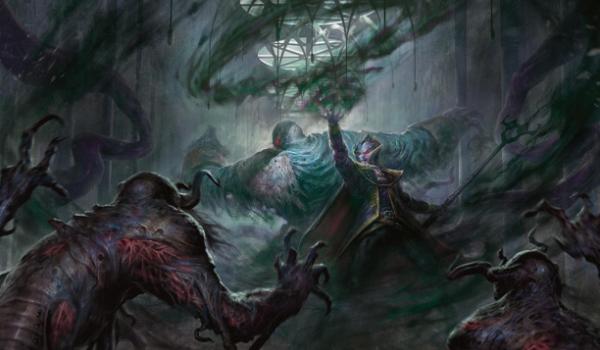
Shifting to actual cards, I'm still reeling from Wizards' tragic exclusion of Innocent Blood from the best Innocent Blood-themed set in recent memory, although it was an excepted blow once I learned about the awful Oath of Liliana. Between the underpowered Oath and Standard's power-level demoting Accumulated Knowledge to unplayable sorcery speed, I wasn't exactly surprised to see Blood's exclusion when we got the final Moon roster last Friday. Thankfully for a Modern crowd spoiled by format-defining staples in the last few sets, Eldritch Moon did not fully disappoint---the set offers numerous playable cards for the format's many top-tier strategies. Today, I'll review my top five Modern playables from Eldritch Moon along with some honorable mentions that barely missed the final cut.
[wp_ad_camp_1]
Honorable Mentions
Not every card can make a top five list, and Eldritch Moon has more than a few contenders for those coveted slots. It's possible I might have swapped some of these onto the main list with a bit more testing, but given my current results and the overall conversations around these cards, I'm more comfortable with them on the bench than the main stage.
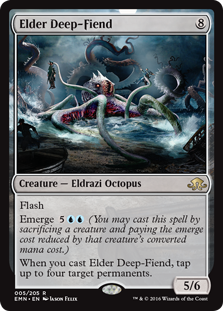 Elder Deep-Fiend
Elder Deep-Fiend
This uncounterable Mistbind Clique effect is absolutely unfair in the Bant Eldrazi vs. Jeskai, Scapeshift, or other blue-based control matchup. Playing this on turn three off turn two Eldrazi Temple and Matter Reshaper, plus that silly on-cast tapdown, feels like cheating. Opponent counters the Fiend? Good luck handling the subsequent Thought-Knot Seer or Reality Smasher on turn four. Opponent doesn't counter the Fiend? Between Fiend and the creature you play next turn, you probably have a 1-2 turn clock. If you love emerge but don't love the Deep-Fiend, also check out the Eldrazified Siege Rhino in Abundant Maw.
- Spell Queller
This could easily become a tempo all-star, particularly in tandem with the undervalued Disrupting Shoal to occupy the tricky three-slot. Delver of Secrets // Delver of Secrets loves flipping on turn two with Goremand backup and then Queller following on turn three; it even saves you from the Abrupt Decay! In my limited testing, you felt invincible untapping on turn three with a clock in play and a Queller in hand, and this might have been rated higher if I had more reps on the different Queller decks being thrown around online (Delver variants, Spirits variants, Bant variants, etc.).
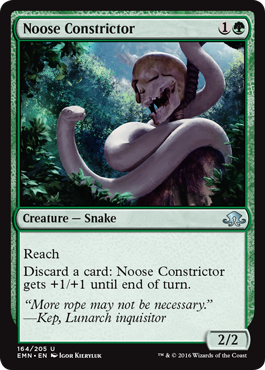 Noose Constrictor
Noose Constrictor
At least we got one noteworthy Odyssey block reprint! I was a longtime Wild Mongrel fan, which makes Constrictor my hands-down favorite card of the set. I see the Snake enabling some combination of madness and delirium decks, although it's unclear how those strategies will perform in our powerful format. This uncertainty makes it hard to test optimal Constrictor builds, and keeps Mongrel 2.0 off the main list.
- Selfless Spirit
Dauntless Escort's spiritual successor is a solid, albeit boring, addition to Kiki Chord and Abzan Company. Flying is relevant both defensively against decks like Affinity and Infect, but also offensively when decks like Abzan Company switch gears to the Gavony Township plan. Burrenton Forge-Tender will likely still get the nod in certain metagames, but Spirit takes an edge in beating hard Wrath sweepers, shielding against Pulse/Decay/Exterminate! removal, and winning messy combat phases.
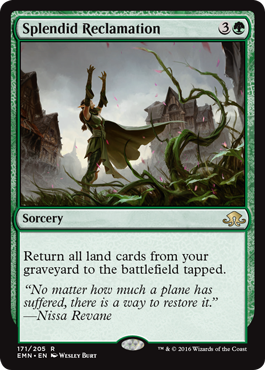 Splendid Reclamation
Splendid Reclamation
I struggled between placing this on the formal top five or shifting it to the runner-ups. I'm settling with "honorable mention" because I couldn't figure out the Valakut, the Molten Pinnacle shell to get this working, even if that doesn't mean it's not out there for someone else to find. Like Scapeshift, Reclamation is a four-mana sorcery which can serve as a functional one-card combo with the requisite setup. Reclamation diverges from Scapeshift in requiring a graveyard setup, and that's where the brewers need to get working. Does this pair with Golgari Grave-Troll and other dredgers? Assault Loam standby Seismic Assault? A backup, or even Plan A, for traditional or Prismatic Omen Scapeshift? I'm not certain where this ends up, but I'd be shocked if someone didn't get it working by the end of 2016.
Want to prove me wrong and vindicate your pet Moon favorites? Head down to the comments with some arguments and/or test results; I'd love to see some alternate takes on these potential diamonds in the rough. I'd also love to hear more about cards I didn't test as intensively, such as Nephalia Academy (I'm worried about anti-discard mechanics that need to be played early and can't produce colored mana), Grim Flayer (can we get actually delirium to work?), and others.
With all our participation medals handed out, let's now turn to the winner's pedestal and see who made the top five cut.
5. Emrakul, the Promised End
M'Emrakul! We meet again! The last time we checked in on Innistrad's cosmic terror, I'd conducted a series of RG Tron tests swapping out Ulamog, the Ceaseless Hunger for Emrakul, the Promised End. Early results were promising, although not conclusive, and I immediately liked Emrakul as a metagame call in RG Tron lists. You can reliably cast the Eldrazi titan for 11 mana, which typically drops to 10 with help from Lightning Bolt, dead planeswalkers, and Ghost Quartered lands. Or your own Ghost Quarter/Sanctum of Ugin (Sanctum in particular is excellent here)! In that 10-11 mana range, Emrakul compares favorably to Ulamog, making her a viable replacement in metagames where the Mindslaver effect is decisive.
 Since those initial evaluations, I've jammed far too many MTGO leagues with my RG Tron list. In between losing to Infect, Bogles, Ad Nauseam, Mill, Dredge, and other representatives of the online linear plague, I've been keeping close track of where Emrakul would have saved me when Ulamog was insufficient. I've also conducted some direct Emrakul tests in between tilted league finishes. Overall, the findings only reinforced my early assessment.
Since those initial evaluations, I've jammed far too many MTGO leagues with my RG Tron list. In between losing to Infect, Bogles, Ad Nauseam, Mill, Dredge, and other representatives of the online linear plague, I've been keeping close track of where Emrakul would have saved me when Ulamog was insufficient. I've also conducted some direct Emrakul tests in between tilted league finishes. Overall, the findings only reinforced my early assessment.
Emrakul was particularly game-breaking against Infect, where Ulamog on Blighted Agent/Blinkmoth Nexus would frequently meet a Vines of Vastwood. Emrakul dispatches both with tentacled aplomb, forcing the Inkmoth to swing right into her eldritch maw and expending all Infect's pump resources on the Agent. This typically lines up Infect for a guaranteed loss in the next turn or two. Burn, Affinity, Suicide Zoo, and other similar decks often meet similar ends to the Mindslaver effect, further differentiating Emrakul's strengths from Ulamog's. All this points to Emrakul occupying RG Tron slots in the future, and I'm excited to try out two copies on MTGO when Moon hits online vendors soon.
4. Eternal Scourge
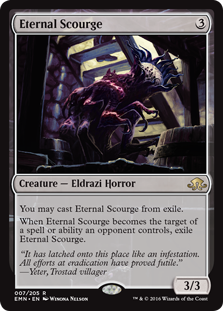 I've heard players assess Eternal Scourge as Modern's Nether Spirit and just another Misthollow Griffin. And you can't even pitch the Scourge to Force of Will in Legacy Food Chain combo! I'm not certain about where exactly Scourge is going to find a home, but I've identified enough Scourge synergies in testing that I'm calling this creepy little weirdo a winner.
I've heard players assess Eternal Scourge as Modern's Nether Spirit and just another Misthollow Griffin. And you can't even pitch the Scourge to Force of Will in Legacy Food Chain combo! I'm not certain about where exactly Scourge is going to find a home, but I've identified enough Scourge synergies in testing that I'm calling this creepy little weirdo a winner.
Gray Ogres aren't exactly what you want to be doing in Modern, but Watchwolf is quite a bit better, and that's exactly where Scourge ends up in tandem with Eldrazi Temple. Semi-hexproof Watchwolf is even better, with Scourge coming back for more every turn. Admittedly, Scourge's self-exiling clause can be a liability against some forms of removal that wouldn't otherwise kill the Eldrazi for good: watching Scourge die to Gruul/Suicide Zoo's Mutagenic Growth is uniquely aggravating. Corner-cases aside, however, most removal that kills Scourge is going to kill any "two-mana" 3/3. This notably includes two of Jeskai Control's best removal options, Path to Exile and Nahiri, the Harbinger, which are both laughable against the unkillable Horror.
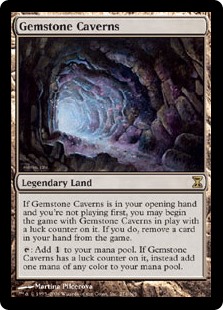 Looking beyond its base stats, Eternal Scourge also lends itself to various teched-out lines of play. You know what sounds unfair? Turn zero Gemstone Caverns pitching the Scourge into turn one Eldrazi Temple, playing the Scourge. Follow that up with a turn two Thought-Knot Seer and your opponent is going to feel like Eye of Ugin is legal again. Scourge also plays well alongside Relic of Progenitus (remember that Scourges dying in combat don't naturally exile), Rest in Peace, and even Scavenging Ooze. I'm also sure there's something stupid here involving Heartless Summoning.
Looking beyond its base stats, Eternal Scourge also lends itself to various teched-out lines of play. You know what sounds unfair? Turn zero Gemstone Caverns pitching the Scourge into turn one Eldrazi Temple, playing the Scourge. Follow that up with a turn two Thought-Knot Seer and your opponent is going to feel like Eye of Ugin is legal again. Scourge also plays well alongside Relic of Progenitus (remember that Scourges dying in combat don't naturally exile), Rest in Peace, and even Scavenging Ooze. I'm also sure there's something stupid here involving Heartless Summoning.
Overall, Eternal Scourge has the markings of a powerful card. Its ability to fill aggressive, midrange, and even more combo-oriented roles suggests significant Modern potential. I'm excited to see what the Eldrazi brewers do with this one.
3. Eldritch Evolution
I'm still thoroughly unconvinced that Allosarus Evolution is where you want to go with this card, but Eldritch Evolution itself still passes Modern muster. As I wrote about in my Evolution article last week, many deckbuilders have been too distracted by the Allosaurus Rider buyout and synergy to think of Modern's Natural Order as anything other than a combo piece. Stop thinking dinosaurs and start thinking value. Eldritch Evolution is the only creature toolbox bullet that can fetch a two- or three-drop bullet of choice as early as turn two. Chord of Calling doesn't crumble to Goremand, but it also can't tutor your devastating creature until turn three at earliest. In Modern, that's a lifetime. Or, as is often the case, a game loss.
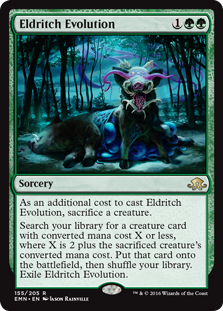 All of the toolbox green decks have bad matchups where spiteful creatures are the difference between a win and a loss. See Abzan Company vs. RG Tron. See Elves vs. Affinity or Infect. In these kinds of matchups, your chances of winning increase dramatically if you can get the hatebear (or hate Ogre) out as early as possible. Evolution lets you do just that by turn two; Aven Mindcensor against Tron; Spellskite against Infect; Kataki, War's Wage against Affinity. The card disadvantage potential is more than outweighed by the haymaker you deploy. Higher on the curve, you can also use Evolution for serious value by converting those Kitchen Finks and Voice of Resurgences into Sigarda, Host of Herons and Siege Rhino. Or, if you still want to try the Allosaurus combo, straight up to Avacyn and Griselbrand and the other bigshots.
All of the toolbox green decks have bad matchups where spiteful creatures are the difference between a win and a loss. See Abzan Company vs. RG Tron. See Elves vs. Affinity or Infect. In these kinds of matchups, your chances of winning increase dramatically if you can get the hatebear (or hate Ogre) out as early as possible. Evolution lets you do just that by turn two; Aven Mindcensor against Tron; Spellskite against Infect; Kataki, War's Wage against Affinity. The card disadvantage potential is more than outweighed by the haymaker you deploy. Higher on the curve, you can also use Evolution for serious value by converting those Kitchen Finks and Voice of Resurgences into Sigarda, Host of Herons and Siege Rhino. Or, if you still want to try the Allosaurus combo, straight up to Avacyn and Griselbrand and the other bigshots.
I expect we see any number of these toolbox decks trying out Eldritch Evolution in Company, Chord, or other slots to shore up bad matchups. I also expect we see a more dedicated Chord and Evolution deck emerge after Eldritch Moon, potentially in Abzan colors and focused around decisive, toolbox creatures and high-value midrange sequences reminiscent of 2014's Rhino Birthing Pod strategies.
2. Collective Brutality
After a rough few weeks of RG Tron meets Infect on MTGO, I was already considering shifting over to a more interactive deck, and Grixis Delver was at the top of my list. Collective Brutality all but solidifies this investment decision, although the escalate sorcery is by no means a Grixis Delver exclusive. This deceptively powerful spell wins my nomination for biggest sleeper of the set, a sorcery-speed Disfigure and bad Duress that many are understandably dismissing. Although I don't see Brutality quite living up to the Kolaghan's Command standard, this two-mana catchall meets all the benchmarks of a powerful Modern roleplayer.
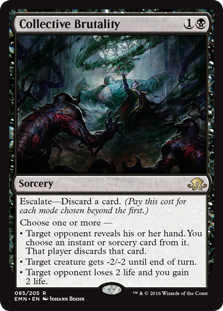 In evaluating a care like Brutality, you're really evaluating seven different cards in one. There's the three single modes, three double-escalated modes (discard/Disfigure, Disfigure/Syphon Life, and discard/Syphon Life), and the single triple-escalated nuke. Thinking through all seven of those possibilities in a Grixis shell, or in an Abzan one alongside Lingering Souls, Brutality is more than capable of carving out decisive advantages throughout the early- and mid-game.
In evaluating a care like Brutality, you're really evaluating seven different cards in one. There's the three single modes, three double-escalated modes (discard/Disfigure, Disfigure/Syphon Life, and discard/Syphon Life), and the single triple-escalated nuke. Thinking through all seven of those possibilities in a Grixis shell, or in an Abzan one alongside Lingering Souls, Brutality is more than capable of carving out decisive advantages throughout the early- and mid-game.
Any combination of discard and Disfigure, even at sorcery speed, is going to make major gains against most of Modern's premier aggressive decks. This includes Burn's Goblin Guides and Eidolon of the Great Revels, along with all its burn spells. It hits Infect's Glistener Elfs and Blighted Agents in one strike and the frightening Become Immense or Vines of Vastwood in the other. Brutality's versatility extends to all the Birds of Paradise decks, where it swats the Birds while simultaneously sniping the Chord or Company. Syphon Life is also relevant, empowering Grixis decks with the lifegain they have historically lacked and echoing Kolaghan's Command's two-point reach.
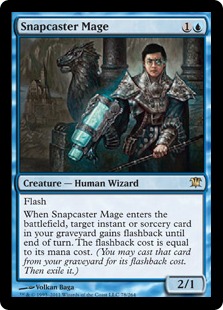 Of course, Brutality offers more than just spell effects. Its discard cost can be just as powerful in the right deck. Abzan strategies can pair it with Lingering Souls for a huge turns 2-3 punch. Snapcaster decks can recover the discarded spells later, use them to fuel an early Tasigur, the Golden Fang or Gurmag Angler (the latter can be hard to turn on by turn three otherwise), or put cards in the bin for later Kolaghan's Command recursion. This also doesn't touch on Brutality's application in graveyard-based combo decks, where the triple effect of early removal, counter-disruption, and discard can be lethal. I'm not looking forward to facing Avacyn and Griselbrand decks that Brutality on turn two before the big turn three Goryo's Vengeance turn.
Of course, Brutality offers more than just spell effects. Its discard cost can be just as powerful in the right deck. Abzan strategies can pair it with Lingering Souls for a huge turns 2-3 punch. Snapcaster decks can recover the discarded spells later, use them to fuel an early Tasigur, the Golden Fang or Gurmag Angler (the latter can be hard to turn on by turn three otherwise), or put cards in the bin for later Kolaghan's Command recursion. This also doesn't touch on Brutality's application in graveyard-based combo decks, where the triple effect of early removal, counter-disruption, and discard can be lethal. I'm not looking forward to facing Avacyn and Griselbrand decks that Brutality on turn two before the big turn three Goryo's Vengeance turn.
Collective Brutality is sure to see both maindeck and sideboard play in Modern's future. My money is currently on Grixis strategies, where the sorcery shores up a rough Burn matchup while also maintaining relevance across the format, but I'm excited to see who else leverages black's newest multitool.
1. Bedlam Reveler
Jordan's not the only one excited about Bedlam Reveler in Modern. I've been testing the Devil in various Delver, Temur, Burn, and similar spell-packed lists, and it's been a major performer so far. Although I don't think Reveler is quite Treasure Cruise with legs, and it's far from the creature to break Burn by the end of the summer, I do see the card making a big Modern impact as a curvetopper across the archetype spectrum. Nowhere should this be more true than in different Delver of Secrets // Delver of Secrets builds.
 We've been seeing Delver strategies slowly creeping out of their Tier 3 morass into more respectable metagame ground, notably with Ryan Overturf's 5th place performance at May's SCG Indianapolis Open, and Kevin Jones' victory at June's SCG Dallas Open. This suggests the strategy has more legs (and wings?) than many gave it credit, and Bedlam Reveler is a tantalizing addition to maintain Delver's metagame momentum. Harkening back to Delver's old Treasure Cruise days, the Devil gives mid- and late-game Delver players a way to refuel and reload after running out of steam. Unlike Cruise, Reveler isn't quite as unconditionally busted, forcing you to pitch your hand and not treating Thought Scours as Dark Rituals. Snapcaster Mage also doesn't break the card in half. Like Cruise, however, Reveler gives you an Inquisition of Kozilek-proof recovery against attrition decks, and one that synergizes with the deck's 27+ instants and sorceries.
We've been seeing Delver strategies slowly creeping out of their Tier 3 morass into more respectable metagame ground, notably with Ryan Overturf's 5th place performance at May's SCG Indianapolis Open, and Kevin Jones' victory at June's SCG Dallas Open. This suggests the strategy has more legs (and wings?) than many gave it credit, and Bedlam Reveler is a tantalizing addition to maintain Delver's metagame momentum. Harkening back to Delver's old Treasure Cruise days, the Devil gives mid- and late-game Delver players a way to refuel and reload after running out of steam. Unlike Cruise, Reveler isn't quite as unconditionally busted, forcing you to pitch your hand and not treating Thought Scours as Dark Rituals. Snapcaster Mage also doesn't break the card in half. Like Cruise, however, Reveler gives you an Inquisition of Kozilek-proof recovery against attrition decks, and one that synergizes with the deck's 27+ instants and sorceries.
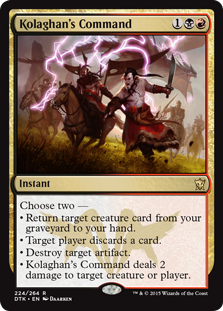 Reveler contributes a number of other strengths to the Delver package, or to any other strategy which can accommodate its casting requirements. For one, its cost-reduction doesn't compete with subsequent Revelers and doesn't get blown out by Goremand. It also is much milder anti-synergy with Tasigur, whose delving can take away fetchlands and creatures before plucking away a few of Reveler's beloved spells. You can't Snapcaster a Reveler, but you can Kolaghan's Command one (or Snapcaster a Kolaghan's!), which further tips the grindy attrition contests to the Delver player. Of course, Bedlam Reveler is also a hardy threat which can easily overpower Tarmogoyfs and put the opponent on a rapid clock.
Reveler contributes a number of other strengths to the Delver package, or to any other strategy which can accommodate its casting requirements. For one, its cost-reduction doesn't compete with subsequent Revelers and doesn't get blown out by Goremand. It also is much milder anti-synergy with Tasigur, whose delving can take away fetchlands and creatures before plucking away a few of Reveler's beloved spells. You can't Snapcaster a Reveler, but you can Kolaghan's Command one (or Snapcaster a Kolaghan's!), which further tips the grindy attrition contests to the Delver player. Of course, Bedlam Reveler is also a hardy threat which can easily overpower Tarmogoyfs and put the opponent on a rapid clock.
Despite an uptick in linear strategies, particularly in the MTGO metagame, plodding Jeskai and hateful Jund are still some of Modern's most-played decks. This creates an opportunity for numerous red, spell-based builds to start incorporating Bedlam Reveler as a countermeasure. I'm confident we'll see Moderners from Mardu to Jeskai Midrange working overtime to test out Reveler, and given its base stats and powerful "draw three cards" line of text, this all but ensures the Horror will find its home in our format.
Eldritch Moon Wrap-Up
I'll be on vacation for the next few weeks, so much of the post-Eldritch Moon testing will need to happen without me. There's also a banlist announcement arriving next Monday, July 18: my relative silence on this update should indicate exactly what I predict it to announce (a resounding "no changes" in an extremely healthy format). I should be back during the week of August 1, hopefully with no more panic-inducing news about buyouts, major format changes, or some new Eldrazi-involved nonsense.
You'll be in good hands with Jason and company until then, and I hear our Editor in Chief has a metagame update planned for the coming week: some internal transitions have delayed this for July. Until then, head down to the comment section with your own Eldritch Moon reviews, test results, and overall thoughts. Did I miss any big cards? Any Moon brews or lists just waiting for their big Modern debut? Let me know and we'll talk soon.





Any thoughts on Mirrorwing Dragon? Granted, it’s a little on the expensive side, but its “if you Path me you lose your own team” ability is very comparable to Sigarda’s hexproof, while also allowing for proactive shenanigans by spreading something like Become Immense or Slip Through Space to your entire team. Fringe curve-topper, like Sigarda?
I have a few issues with Dragon. First, the biggest Path deck (Jeskai Control) can safely Path or Nahiri it without fear of losing any of their creatures; they probably don’t have any. Second, the faster decks can just ignore Dragon entirely because it doesn’t even draw into additional answers. Dragonlord Ojutai, who has actual hexproof, at least threatens to draw answers when it starts connecting. Finally, I don’t know what red decks want this that wouldn’t use Thundermaw Hellkite or Stormbreath Dragon instead, and those decks are all Tier 3 or lower.
Leaving Thalia off this list seems like a big miss to me, that card is all but guaranteed to see play in g/w and mono white hate beard style decks. The decision to leave it off this list is even more vexing after you gave it a B in your bolt test article. I would also wager that imprisoned in the moon is more likely to see serious modern play then either collective brutality or eternal scourge.
I ended up excluding Thalia because I found she was only good in testing on turn two or turn three on the play, and only good against certain decks. All of the other Hatebears/D&T/Abzan Liege/etc. creatures are decent at more points in the game, cost enough less to justify their being a bit worse, and are better in more matchups. That reinforces most of what I said in my Thalia article, but takes it to greater extremes: she’s really good early and really not good late.
I love Imprisoned in the Moon and it could easily have made my Honorable Mentions list as a maindeck blue-based answer to both Tron and x/4+ creatures. Unfortunately, I got literally 3 games in with the card and didn’t have enough results to support that hunch. I’d love to see it work out in UW Control or other Ux lists though.
As a budget modern player, Bedlam Reveler is ringing bells in my head for mono red burn…sideboard at least.
I agree with most all the cards on the list except I was surprised to see that curious homunculus was not on the list. A 2 cmc mana dork for instants and sorceries with a pretty easy flip condition to get to 3/4 prowessing goblin electromancer seems like it has potential namely because of how cheap of a threat it is combined with the fact that you really don’t have to jump through hoops to flip him
I actually found a lot of issues with flipping the Homunculus by turn three. The best way to do it was Thought Scour/Probe on turn one, hoping you hit another instant or sorcery on Scour. You can also get there with Gut Shot, but I’m not sure that’s where this deck wants to be going. Flipping Homunculus on turn four was a bit too slow for my tastes, although I admit I didn’t do too much testing with the card. Maybe decent as a 1-2-of in certain tempo decks, where you can almost always play it on one turn and guarantee a flip past turn four.
Faithless lottint can also flip it
I mentioned it in my spoiler article last week, but Homunculus really doesn’t belong in aggressive decks because the setup it requires makes you play off-curve in a weird way. Delver would rather not put the effort into making him a threat on turn three. Storm is where the card belongs, and I think it competes favorably with Goblin Electromancer in that deck.
I feel like Grim Flayer probably deserves a bit of consideration. Granted, delirium is not as easy to achieve as most people make it out to be, but perhaps a deck like suicide zoo that runs bauble, fetches, tribal flame, and git probe can get there pretty reliably. A 4/4 for 2 with trample that filters your draws and stacks your graveyard for become immense is nothing to scoff at. I suppose the question is is this better than the slots occupied by step lynx or ghor clan rampager.
I dunno, I look forward to testing it.
Overall opinion of lonerider for soul sisters ?
Grim Flayer in any GB/x non aggro deck?
Bant Tamiyo in …. something ?
Grim Flayer could only see play in BG rock, where you want to run Obliterator and thus Bob is a fairly risky choice.
Regarding Bant Tamiyo, the only deck I could see here fit in is a Bant Chord deck. Why not Company? Cause you cannot run that many non creature cards in a Company deck and most of the times Chord is better than Tamiyo in those shells.
The Bant Chord shell would be close to the GW Chord decks with Archangle + Spike Feeder combo with a slight U splash for Reflector Mage (card is bonkers, especially with Chord and Resto), Archmage, Tamiyo and SB counterspells (Negate, Dispel and Unified Will mainly). There are a couple of other U cards, which might see play in that shell (Moorland Haunt, Geist and Meddling Mage e.g.), but I think, the first 4 cards (or card groups) are the main reason to go into U in the first place and not into B for Decay/Melira Combo.
Greetings,
Kathal
I’m with you on 4 of these 5, Sheridan (and I especially like the Gemstone Caverns into Eternal Scourge trick, that looks delightful), but I’m skeptical of Collected Brutality. I understand the “whole is greater than the sum of its parts” argument, and the fact that it weaponizes dead cards in hand/feeds the graveyard for some strategies, but the fact that its effects all happen at card parity and that the removal effect is a rather paltry -2/-2 give me some serious pause. I know that Kolaghan’s Command is the fusion of Funeral Charm, instant-speed Raise Dead, and Shock (individually unplayable) and it sees play, but you get to pick 2 of those for the price of 1 card. I might be a bit too hard on the card, but I don’t see it.
The two cards I’m mostly “hyped” about is Collective Brutality and Haunted Dead.
While Collective Brutality is a fairly obvious card, Haunted Dead is a card, which fits perfectly in the next level Loam decks (the one with Zombie Infestation and Squee). Currently the deck splashes white for Lingering Souls but due to Haunted Dead and the interaction with it between Loam and Squees you can kick white from the deck, since you can get your flying tokens from a black card (the “flashback” is important here). Ghoulsteed sees already play as a 1 off, since a recurring 4/4 is great vs Midrange (Bolt proof and can block everything but Goyf) so there is already potential for these kind of effects in the deck (and thus Lingering Souls replacement).
Regarding Collective Brutality I will like test it as a 4 off in the BR Griselbanned version, since it deals with the annoying stuff (but Cage/RiP which is annoying) while also making the bad Affinity and Infect match-up better (a turn 2 “double” removal spell should buy you more than enough time to close out the game vs Infect). Furthermore, the card has some other advantages too:
– it is black, so you can pitch it to Souls Spike (relevant in the Ooze version, and when it is run as a 5th Shoal)
– it can drain life, for extra draws/a free “shock” (most often you are exactly 1-2 life short to get another redraw, so having another tool to get life is nice here)
– an interaction card, which you can run MD while it “supports” your combo (sometimes you really want to discard stuff but you have no discard outlet)
As for my runner up it is definitely Spell Queller, which looks absurd in a UW Tempo deck with Vial (Vial is the most broken card in Modern, dunno why nobody plays it :/ ). I need to get some test in, before I can make a better statement here, but its interaction with Resto and Flickerwisp looks spicy to say at least.
Otherwise, cards which might be good in context: Blessed Alliance, Coax (UR/UW Tron) and Lilli. However, there are a couple of other cards, which might see play (see Haunted Dead example above), given the right deck.
Greetings,
Kathal
I think I’m missing how 2 Eldrazi temples and sacing a master reshaper can cast an elder deep-fiends emerge cost? How you you pay the 2 islands?
The article says turn three Fiend off “turn two Temple” and Reshaper, not two Temples and Reshaper. The line can be Coast/Pool and Stirrings (T1), Temple and Reshaper (T2), and then Coast/Pool and Fiend (T3). Reshaper reduces Friend’s cost to 2UU which the lone Temple and two Islands (or any blue producing lands) covers.
I like ishkanah, grafwidow. You get 6/11 across four bodies and a 4 point drain every turn. Totally a top end finisher, but 5cc isn’t out of line.
I’m hoping Collective Brutality is enough to push my favorite obscure deck into a powerhouse. I’ve been messing around with B/W Smallpox builds for a couple years, and I am loving being able to test it in a Smallpox, Bloodghast, Lingering Souls, Myth Realized, and Kalitas list. It gives the deck a level of versatility and consistency it has needed.